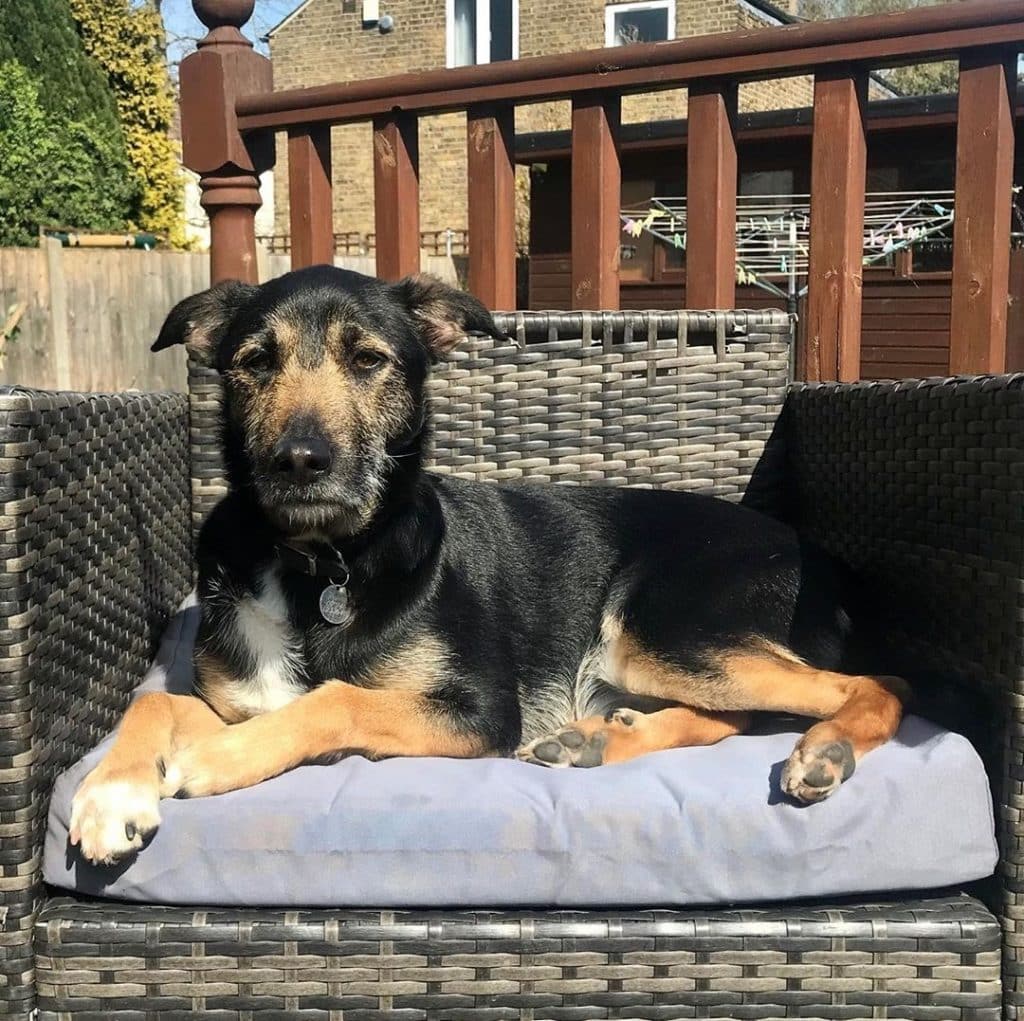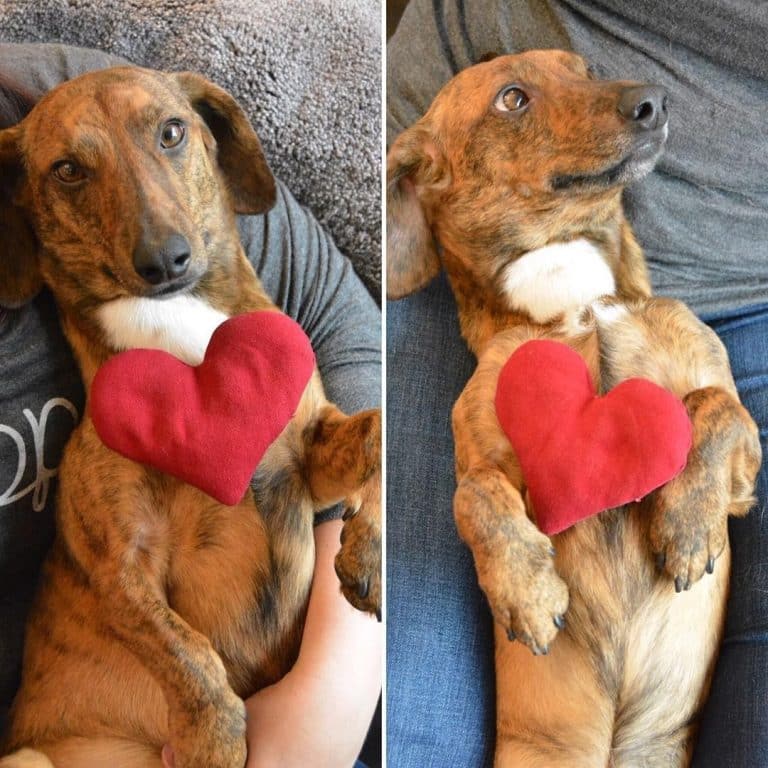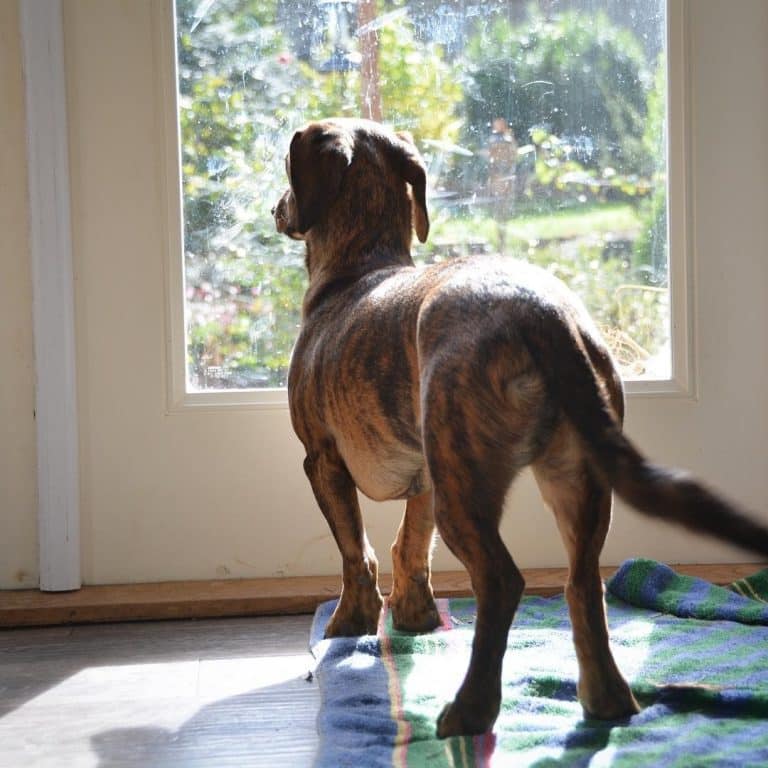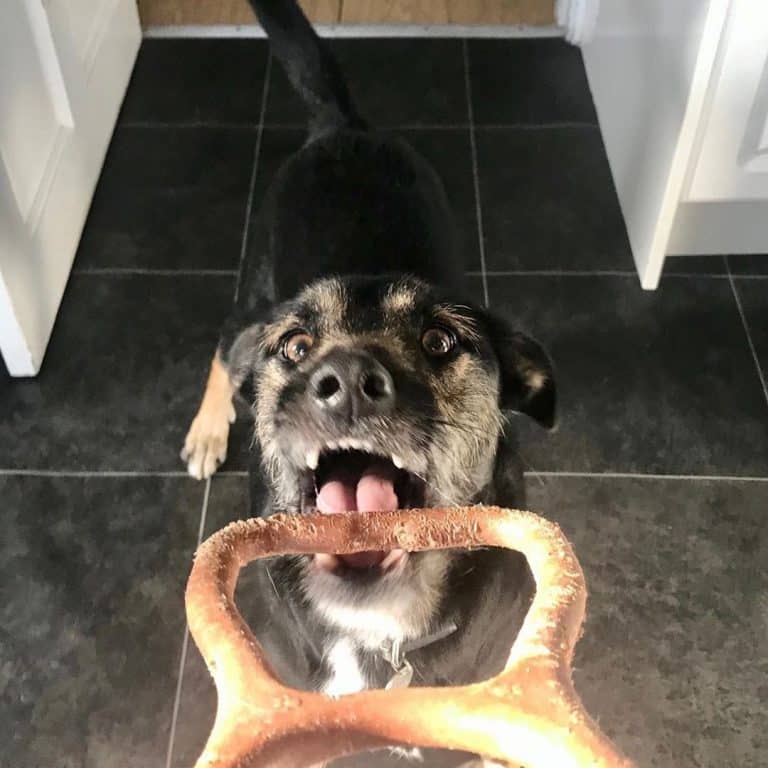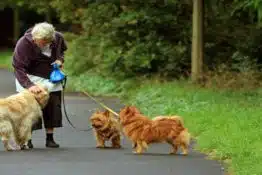
Long Legged Dachshund: A Surprisingly Tall Boy
Credit: manuelthemutt
Dachshunds, or Doxies, are one of the most beloved dog breeds in the world, famous for their long bodies and short legs. This funny feature earned them their popular nickname—the Sausage Dog.
Many variations are recognized as the breed standards, so Doxies can vary in size, coat type, and color. The exact proportions of their bodies are not set in stone among the breeders and kennel clubs, but most agree that the 1.8:1 ratio is optimal.
Different proportions are also accepted, but Dachshund must be longer than taller to meet the official breed standards. Extreme variants are not welcome because they can cause health problems and make moving and walking difficult.
If your Sausage Dog has a bit longer legs, it does not automatically mean that they are flawed or impure. But, if they do not fit the body structure of the Dachshund, it can imply that there has been some mixing with other breeds in their lineage.
Long Legged Dachshund Traits
All Doxies have elongated backs and short and sturdy legs. Their tails are also long, adding to their comical appearance. Regardless of these traits, Dachshunds are strong and stable dogs with exceptional stamina and a sharp sense of smell.
The One Thing Pet Owners Regret Not Doing Until It’s Too Late
Is your pet safe?
1 in 3 pets will need emergency veterinary treatment each year and it is estimated a pet receives emergency care every 2.5 seconds in the U.S.
The average cost of treating a broken bone in dogs is $2,700. Cancer treatments? Up to $10,000.
It’s why so many pet owners say their biggest regret isn’t the vet bill—it’s not having pet insurance when they needed it most.
Ask yourself: “If an unexpected $5,000 vet bill hit tomorrow, could I afford it?”
If the answer is no, it’s time to get covered.
Take a look at Lemonade. They have a great app that actually works, they have an instant chatbot that is faster and, dare we say it, friendlier than most companies’ “real” customer service and a quick scroll through Reddit will uncover… people are really vibing with this brand.
So go check them out and take a look. It takes less than a minute.
Their eyes are oval and wide-set, while floppy ears gracefully frame their faces. The muzzle is long, and they have a mighty scissor bite. The paws are paddle-shaped and allow these pooches to dig deep and fast. Dachshunds come in two sizes:
- Standard—weighing up to 32 lbs and reaching up to 11 inches in height
- Miniature—weighing up to 11 lbs and reaching up to 6 inches in height
When it comes to the height-length ratio, it should not go over 2:1. But, what would be a disqualifying minimum is not entirely clear. In some cases, it can go down to 1.6:1. Not all Doxies are the same. Some pooches can have significantly longer legs than other pups from the same litter.
Some experts claim that the coat type can determine the height-weight ratio. Three coat variants comply with the breed standards:
- Long and silky
- Short and smooth
- Wiry
The least common type, the Wiry Weenie, is most likely to have a bit longer legs than the other two. You should be aware that we are talking about a difference of one or two inches, and anything above that would be out of the ordinary.
While the color palette is broad and can range from black to piebald and anything in between, there is no evidence that it affects the body structure of the dog in any way.
| Weight |
|
| Height |
|
| Size |
|
| Coat type |
|
| Coat color |
|
| Shedding | Moderate to considerable |
| Eyes |
|
| Nose |
|
| Ears | Floppy |
| Temperament | Active and friendly |
| Life expectancy | 12–16 years |
| Hypoallergenic | No |
| Kid-friendly | Yes (for children over five) |
| New owner friendly | No |
| Breed recognition | No |
Why Some Doxies Have Long Legs
If your Doxies doesn’t match the required standards of the breed in leg length, it can imply one of the following:
- The pooch is not a purebred. It is not uncommon for the breeders to fake the documents, and you wouldn’t be the first victim of such a scam.
- The pooch is a purebred. But some sort of “silent” gene was activated, causing the unusual trait to manifest itself.
You should be aware that the latter option also means that there is another breed somewhere in your dog’s family tree. Your pup’s parents and grandparents can show all the typical traits of a Doxie, but at some point in breeding history, there was an intrusion of another breed into the family.
Genes are tricky because they can be dormant for generations and become active at any time in the genealogy. It wouldn’t be surprising that your puppy’s brothers and sisters from the same litter do not have such a feature.
If the trait is too obvious, your dog will not be able to participate in the exhibitions or mate with other purebred Doxies. You should be aware that long-legged Dachshunds are not rare and unique specimens, and this feature will not add to their desirability or put them among the top 10 world’s most expensive dog breeds to own.
It is also crucial to understand that it is not a conformation issue or a congenital disability. Puppies with longer legs will be healthy, active, and friendly as any other “regular” Doxie. Although they may not be dog show material, they can be enjoyable and loving pets.
Doxies with Long Legs–Willful and Smart
Credit: tigerwiener
Dachshunds are among the most intelligent of dog breeds, but with the brains comes a bit of an attitude. They can be demanding when it comes to training because they are strong-willed and independent.
The Sausage Dog is active and curious. They are always on the lookout for a new adventure, and they love to explore. Being territorial and protective, they can become aggressive, but that is a trait that you can control easily with proper techniques.
Expressive and vocal, Doxies like to show you how they feel. This means that they can grow up to be heavy barkers. You can also put this under control by addressing the issue from an early age.
One thing is sure—Dachshunds are incredibly devoted and affectionate with their humans, so if you take the time to work with them, they will be fantastic companions and your best friends forever.
Longer legs will not make your pup any different than the other Doxies. They will be loyal, loving, and probably quite opinionated. And that is why we love Sausage Dogs so much. If you do too, or you know someone who does, put a smile on their face by getting them one of the Dachshund-inspired gifts — we’re sure, they’ll love it!
Dachshund’s History
Weenies come from Germany, where we can trace them to the 15th century. Their primary role was to help hunt small prey, like badgers and foxes. Their name means the Badger Dog in German.
The elongated body made them very successful in catching den animals. They were able to crawl into the deepest hideaways and extract small game, sometimes pulled out by their fellow human hunters by their long tails.
Long legs would only get in the way in this scenario, so the breeders focused on keeping them as short as possible. During the development of the Badger Dogs, there has been mixing with other breeds, most likely Terriers and Spaniels. Long-haired and Wiry Doxies are a result of this cross-breeding. There is no evidence that breeders tried to develop long-legged Dachshunds at any point in history.
Hunting was not the only talent of the Sausage Dog as they proved to be excellent watchdogs and cheerful companions. Americans fell in love with the breed, and they rose to fame once they conquered the New Continent in the 19th century.
With German name and descent, Dachshunds fell out of favor during World War II. They made a dashing comeback in the 1950s, reaching the 12th place on the American Kennel Club’s list of the most popular dog breeds. Even the famous Picasso wasn’t able to resist one of these charmers!
Training the Dachshund with Longer Legs
With the reputation of being stubborn, Doxies can be a handful when it comes to training. This doesn’t imply that they can’t be taught to behave. It means that you are embarking on an adventure that will make you and your pooch better and smarter along the way.
Training is a two-way street with Sausage Dogs. You will have to make a lot of compromises, but these lovely pups will not disappoint you in any way. If you are a first-time owner, check out five mistakes to avoid when training your dog.
Every successful Dachshund training should include:
- Teaching commands
- Socialization
- Potty training
Commands and Rules
This part of the training process is not about raising a circus animal. It is about keeping your pooch safe. Essential commands like No and Stop can save the life of your baby, especially if you live in a city. Follow these guidelines to achieve maximum results:
- Establish yourself as the pack leader. Your pooch must respect you and follow your leads in any situation or conflict. Impose your decisions as final from the beginning.
- Use positive reinforcement. The best way to train your puppy is a reward system. Arm yourself with sweets and give your pup a treat and a pat every time they do something right. You should punish them for misdemeanors, but don’t overdo it. They won’t respond well to cruelty.
- Get the best training collars. Many aids can speed up the training process and make it more effective. Collars are great because they are humane and dog-friendly.
Socialization
You should start socializing your furry friend from puppyhood. This process is crucial because all dogs need to belong to feel secure, even the strong-willed Doxies. To make sure you raise a happy puppy, include the following into your routine:
- Playtime with other dogs. Your baby needs to mingle with their peers to develop courage and trust.
- Visiting new places. Take your dog to a new park, a friend’s home, or just change the usual walking route from time to time. This will allow them to explore unfamiliar surroundings and feel safe in new territories.
- Introduce them to as many people as possible. It will make them less wary of strangers and tone down the need to bark.
Long Legged Doxie’s Activity Requirements
Credit: tigerwiener
Badger Dogs are active and outdoorsy. If your pooch has longer legs, they can only be more demanding when it comes to physical activity. If you don’t like spending too much time outside, then Dachshunds are not the breed for you.
They require at least two or three walks per day with plenty of off-the-leash time to be able to sniff around and explore. Chasing and digging are among Doxies’ favorite activities, so expect them to run around quite a lot.
Mingling with other pooches should be a part of the routine. They also love a good mental challenge, so try to teach them tricks regularly. You can do this at home as well, which can come in handy during cold and rainy days. Dachshunds tend to like interactive toys, so give them one every time you leave the house. It will keep your furniture safe.
| Activity level | Recommended miles/week | Activity minutes/day |
| High | 7 miles | 60 minutes |
Grooming the Dachshund with Long Legs
The grooming rituals of the Doxie depend on the coat type and not on the body structure. The Short-Haired Dachshunds are easy to maintain while the other two types are a bit more demanding.
If you have a long-legged Sausage Dog, they will probably have wiry fur. In that case, besides the weekly brushing, you will have to use a de-shedder at least once a month. Dachshund care will always involve paying particular attention to their coat, so you should trim it twice a year. It’s the best way to keep the upper layer and the undercoat healthy.
Floppy ears are prone to infections, so clean them regularly with doggy wet wipes. Nails are equally important. If clipping seems too complicated, take your pooch to a grooming salon.
Never neglect the teeth. Brush as often as you can, and provide any of the top 10 best dog dental chews to keep the gums healthy.
| Brushing frequency | Brushes for Dachshunds |
| Weekly |
|
The Health Risks of the Long-Legged Dachshund
The most significant risk to the health of the Badger Dog is the elongated spine. It makes them prone to back injuries. If you happen to have the pooch with longer legs, this risk may be less significant because long extremities will provide more stability. Nevertheless, you need to make sure that your fluffer has healthy joints.
Another common danger is obesity. Doxies love to indulge, and it is your responsibility to take care that they don’t become overweight. Most dogs will have a taste for the worst dry dog food because it is filled with taste enhancers, so don’t give in to your pup’s preferences. Inadequate diet can also trigger skin problems, such as dry skin or allergy flare-ups, and it is best avoided. As dogs age, the potential health risks increase, so adjust their activities and switch to the best senior dry dog food.
Dachshunds tend to be healthy and resilient throughout their lifetime, but you should consult with your vet on any concerns that you may have and take your baby on regular check-ups to stay on the safe side. This is particularly essential if your pooch suffers from epilepsy and has recurring seizure episodes. For additional advice, check out our 10 tips on keeping your dog healthy.
| Major concerns | Minor concerns | Occasional tests |
|
|
|
Long-Legged Sausage Dog Eating Habits
Credit: manuelthemutt
A recommended daily intake for Dachshunds should be up to one cup of the best dry dog food for small dogs. Pups with longer legs should follow the same pattern. It would be wise to split the portion into two meals to avoid any gastrointestinal issues and discomfort.
The menu should be versatile, so don’t hesitate to make a healthy home-cooked meal for your baby. You can also add some best canned dog food to spice things up. Doggy sweets are fine, as long as you avoid the worst dog treat brands. They can make your dog overweight.
A healthy diet is essential for the health of your pup. If you are not sure about what to serve to your furry friend, try any of the dogs’ favorites:
- Wellness Core Original Grain Free Dry Dog Food
- Hill’s Science Diet Dry Dog Food, Chicken Meal, Barley & Rice Recipe
- Royal Canin Canine Health Nutrition Adult Beauty Canned Dog Food
Longer-Legged Weenies and Families
Dachshunds are fantastic pets and loyal friends. They can adapt to apartments quickly, so it’s not necessary to have a yard to keep them happy. All climates suit these adorable pooches, and they can get along with other pets if you work on their relationship.
If your kids are under five, you should wait before getting a Doxie or any other dog. Small children can sometimes see the dogs as toys and can unintentionally hurt them. Older kids and Weenies will be best friends.
Everybody should think twice before getting a dog because they are a huge responsibility. Irresponsible ownership can cause many problems, so consider these Dachshund facts before you make a decision.
Top Reasons to Get a Doxie
- They are intelligent and friendly.
- They are easy to maintain.
- They are healthy and resilient.
Top Reasons to Avoid a Doxie
- They require a lot of physical activity.
- They can be stubborn.
- They tend to be loud barkers.
Gorgeous Dachshund Mixed Breeds
Having a hybrid does not mean that your dog is any less beautiful, smart, or devoted. You should love and respect them for their affection and personality and not their genealogy. We strongly recommend adoption over buying because it’s brave and humane. For additional ideas, you can check out some of the best dog breeds to adopt.
| Dachshund Pug mix | Dachshund Lab mix | Dachshund Beagle mix |
| Dachshund Golden Retriever mix | Dachshund Pitbull mix | Dachshund Corgi mix |
| Chihuahua Dachshund mix | Jack Russell Dachshund mix | Dachshund Poodle mix |
| Dachshund Yorkie mix | German Shepherd Dachshund mix | Dachshund Terrier mix |
| Pomeranian Dachshund mix | Cocker Spaniel Dachshund mix | Shih Tzu Dachshund mix |
| Min Pin Dachshund mix | Basset Hound Dachshund mix | Dachshund Husky mix |
| Maltese Dachshund mix | Dachshund Dalmatian mix | Australian Shepherd Dachshund mix |
| Border Collie Dachshund mix | Rottweiler Dachshund mix | Doberman Dachshund mix |
| Papillon Dachshund mix | Rat Terrier Dachshund mix | Italian Greyhound Dachshund mix |
| Bulldog Dachshund mix | Blue Heeler Dachshund mix | Boxer Dachshund mix |
| Great Dane Dachshund mix | French Bulldog Dachshund mix | Weimaraner Dachshund mix |
| Dachshund Boston Terrier mix | Cavalier King Charles Spaniel Dachshund mix | Cairn Terrier Dachshund mix |
| Shiba Inu Dachshund mix | Dachshund Bichon mix | Pekingese Dachshund mix |
| Schnauzer Dachshund mix | English Cream Dachshund |
Best Dog Food for Long-Legged Dachshunds

- Essential, high-quality protein for healthy muscle development, and carbs for energy for an active life.
- Calcium, phosphorus and essential vitamins for strong bones and teeth.
- Glucosamine is added for joint health and mobility support.
- Vitamins, chelated minerals and antioxidants contribute to your pup's immune system health.
- No corn, wheat, soy or chicken (or poultry) by-product meals.
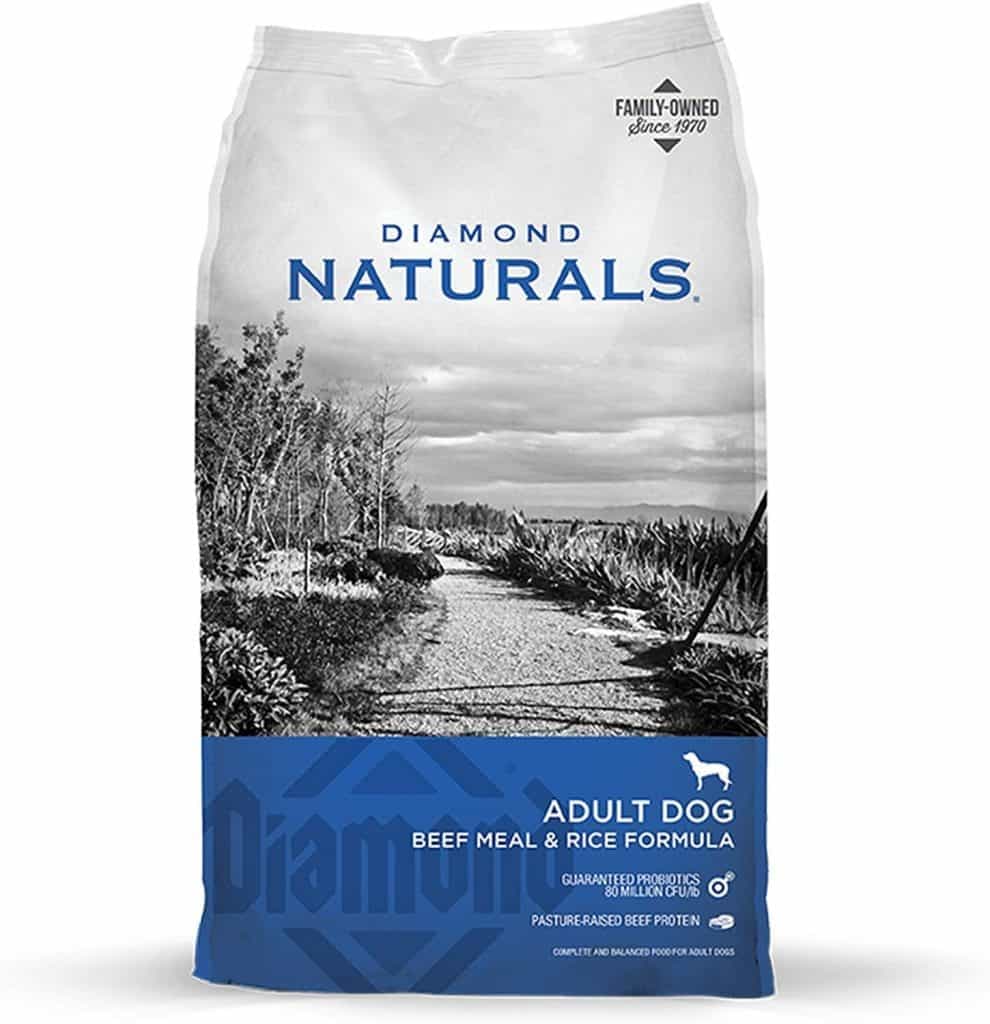
- Made in the USA by a family-owned company using quality ingredients from trusted domestic and global sources.
- With real pasture-raised beef protein as the #1 ingredient, this recipe helps support bones, joints and lean, strong muscles.
- Beef protein provides energy and muscle building blocks, omega fatty acids promote skin and coat health and superfood fruits like blueberries and oranges offer vitamins and minerals.
- Each serving includes species-specific K9 strain proprietary probiotics, plus antioxidants and prebiotics to help support healthy digestion, immune system health and overall wellness.
- Made without corn, wheat, artificial flavors or colors.

- Protein-rich formula features chicken, lamb, and salmon—and chicken is the first ingredient!
- Contains a blend of 15 superfoods including coconut, chia, kale, and blueberries that promote coat and skin health.
- Recipe specially formulated for senior dogs using only high-quality, real ingredients to provide complete and balanced nutrition.
- Ingredients are sourced from trusted farmers and rigorously tested for quality and food safety.
- No artificial preservatives, flavors, or colors, and chicken by-product meal, corn, wheat, and soy protein free.
(FAQs) about Long-Legged Dachshunds:
What is a Long-Legged Dachshund?
A Long-Legged Dachshund is a variation of the traditional Dachshund breed, characterized by longer legs and a more elongated body compared to the standard Dachshund.
How do Long-Legged Dachshunds differ from standard Dachshunds?
Long-Legged Dachshunds have, as the name suggests, longer legs than the standard Dachshund. This variation can affect their overall appearance and, to some extent, their gait.
What is the size of Long-Legged Dachshunds?
Long-Legged Dachshunds typically fall within the same size range as standard Dachshunds. They are generally small to medium-sized dogs with longer legs, making them appear somewhat taller.
What is the temperament of Long-Legged Dachshunds?
Long-Legged Dachshunds share the spirited, clever, and friendly temperament of standard Dachshunds. They are known for their loyalty and make excellent family pets.
Do Long-Legged Dachshunds have specific exercise needs?
Long-Legged Dachshunds, like their standard counterparts, have moderate exercise needs. Daily walks and playtime are usually sufficient to keep them happy and healthy.
Are Long-Legged Dachshunds prone to back problems like standard Dachshunds?
While longer legs might alter the dynamics, Long-Legged Dachshunds, like standard Dachshunds, are still at risk for back problems. Care should be taken to avoid activities that could strain their backs.
What is the grooming routine for Long-Legged Dachshunds?
Grooming needs are similar to standard Dachshunds. Regular brushing, nail trimming, and dental care are important for their overall well-being.
Are Long-Legged Dachshunds good with children and other pets?
Long-legged dachshunds are generally good with children and other pets, provided they are socialized from a young age. Their friendly nature makes them adaptable to family life.
Do Long-Legged Dachshunds have specific health concerns?
While they share some health concerns with standard Dachshunds, the longer legs might influence joint health. Regular vet check-ups and a balanced diet are essential for their overall health.
What are some considerations for potential Long-Legged Dachshund owners?
Prospective owners should be prepared for a lively and affectionate companion with the unique characteristics of the Long-Legged Dachshund. Understanding their exercise needs, grooming requirements, and potential health concerns will contribute to a happy and healthy relationship.
References
- https://en.wikipedia.org/wiki/Dachshund
- Claire, Roxanne St. Dachshund through the Snow. South Street Publishing, 2019.
- Brown, Nathan P., et al. “Development of a Canine Rigid Body Musculoskeletal Computer Model to Evaluate Gait.” Frontiers in Bioengineering and Biotechnology, vol. 8, Nov. 2020, doi:10.3389/fbioe.2020.00150.
80% of Dogs Develop Arthritis or Joint Pain by 7 Years old – Here’s How to Protect Them
Most of us train our dogs when they are puppies to jump up on furniture. We think it’s harmless (and easier than always lifting them), but for dogs, couches and beds are very high compared to the size of their bodies.
Every time they jump it compresses their back and applies enormous force to their joints.
It’s no wonder that an incredible 80% of dogs experience arthritis or joint pain by only 7 years old.
Luckily, there is a vet-recommended solution.
It’s the PawRamp by Alpha Paw. An adjustable ramp that allows dogs to safely get on and off couches and beds. PawRamp makes joining you in bed or on the couch effortless and fun.
As a bonus, you can use code SAVE35 to get $35 off the PawRamp today.

